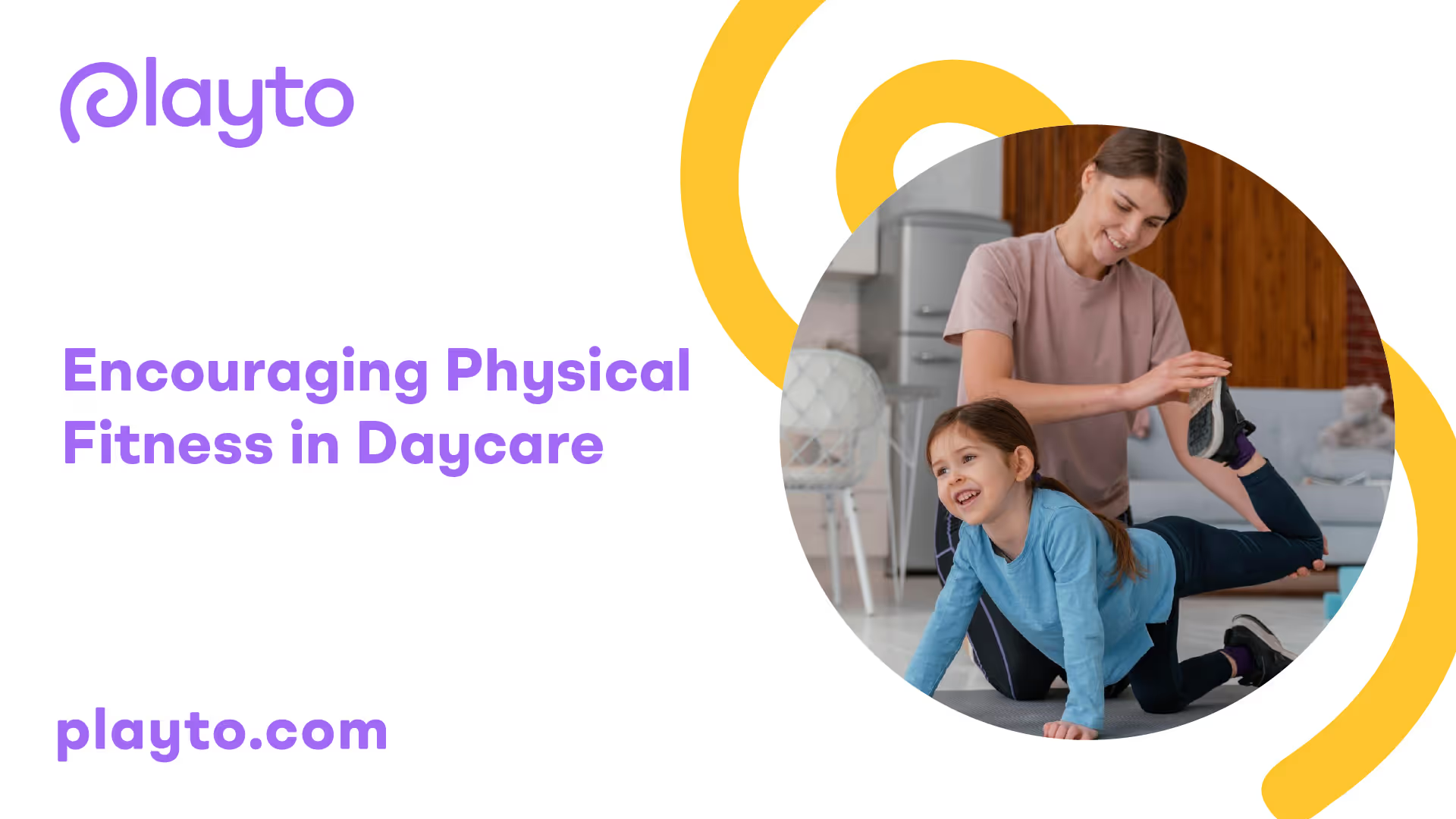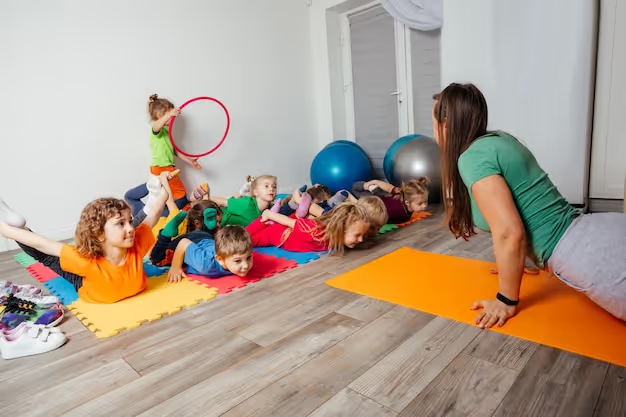
Importance of Physical Activity in Daycare
Physical activity plays a vital role in the development and well-being of children in daycare. Engaging in regular exercise not only benefits their immediate health but also has long-term effects on their overall growth and development. It is crucial for daycare centers to recognize the importance of encouraging physical fitness among children under their care.
Benefits of Physical Activity
Regular physical activity offers numerous benefits for toddlers and preschoolers. According to Playworld, these benefits include:
- Reduced risk of disease: Physical activity helps to improve cardiovascular health, maintain a healthy weight, and reduce the risk of chronic conditions such as obesity, diabetes, and heart disease.
- Boosted energy levels: Engaging in physical activities enhances children's stamina and energy levels, allowing them to participate actively in daily tasks and play.
- Stronger muscles and bones: Regular exercise helps children develop stronger muscles and bones, promoting proper growth and reducing the risk of injuries.
- Improved mental health: Physical activity has a positive impact on mental well-being. It can help reduce anxiety, stress, and symptoms of depression in young children.
- Enhanced cognitive function: Engaging in physical activities can improve cognitive function, including attention span, memory, and problem-solving skills. Children who participate in regular exercise tend to perform better academically.
Long-Term Health Effects
Encouraging physical activity in daycare sets the foundation for a healthy lifestyle that can have long-term effects. By promoting an active lifestyle during these early years, children are more likely to carry these habits into adolescence and adulthood.
According to Playworld, children who engage in regular exercise tend to have longer attention spans, fewer behavioral challenges, and perform better in school. Additionally, they are more likely to maintain a healthy weight, reducing the risk of obesity-related health issues later in life.
To ensure that physical activity is appropriately integrated into daycare routines, it is important for daycare providers to follow guidelines provided by reputable organizations. For toddlers, guidelines recommend at least 180 minutes of physical activity each day to support their social skills, self-confidence, and cooperative abilities [1]. Organizations such as SHAPE America and the Head Start Early Learning Framework offer standards and recommendations to support physical activity and healthy habits in young children.
By recognizing the importance of physical activity in daycare and implementing appropriate strategies, daycare centers can contribute significantly to the overall health and development of children under their care. Encouraging physical fitness at a young age sets the stage for a lifetime of healthy habits and well-being.

Guidelines for Physical Activity
To ensure that children in daycare are engaging in sufficient physical activity, it is important to establish guidelines that cater to different age groups. This section will provide specific guidelines for physical activity for toddlers (ages 1-3) and preschoolers (ages 3-5).
Toddlers (Ages 1-3)
For toddlers aged 1 to 3, physical activity plays a vital role in their development. At this stage, activities should focus on encouraging the use of gross motor skills, such as learning to walk and throw, which aid in their overall physical and cognitive development.
According to guidelines provided by SHAPE America, toddlers aged 12 to 36 months need at least 180 minutes of physical activity each day to support the development of crucial social skills, self-confidence, and cooperative abilities. This physical activity can be achieved through a combination of structured and unstructured play, both indoors and outdoors.
Here are some key considerations and recommendations for physical activity for toddlers in daycare:
- Encourage at least 60 minutes of structured and unstructured physical activity throughout the day, every day. This can include activities such as crawling, walking, running, climbing, playing with balls, and exploring their surroundings.
- Plan regular intervals of unstructured playtime to allow toddlers to engage in self-directed physical activities.
- Incorporate activities that promote the development of gross motor skills, such as kicking, throwing, catching, and balancing.
- Provide a safe and stimulating environment that allows for exploration and movement.
- Engage in interactive play with toddlers to promote social interaction and cooperative play.
Remember that these guidelines are general recommendations, and it's important to consider each child's individual needs and abilities when planning physical activities.
Preschoolers (Ages 3-5)
Preschoolers, aged 3 to 5, continue to benefit from regular physical activity. At this stage, physical activities should focus on further developing their gross motor skills, coordination, and balance.
According to the Children's Museum of Sonoma County, preschoolers in daycare should be encouraged to participate in about 60 minutes of physical activity (active play) throughout the day, every day. This can be split into shorter blocks to spread out the fun and movement throughout the day.
Here are some guidelines for physical activity for preschoolers in daycare:
- Encourage at least 60 minutes of structured and unstructured physical activity every day.
- Offer a variety of activities that promote the development of gross motor skills, such as running, jumping, hopping, skipping, and balancing.
- Include activities that enhance coordination and fine motor skills, such as throwing and catching balls, playing with hula hoops, and using jump ropes.
- Provide opportunities for creative movement, dance, and active games that encourage social interaction and cooperation.
- Incorporate music and movement activities to make physical activity enjoyable and engaging.
By providing a range of activities that cater to the specific age group, daycare centers can ensure that toddlers and preschoolers are getting the physical activity they need for their overall development. For more information on promoting physical activity in children, check out our articles on encouraging self-help skills in daycare children and encouraging positive self-image in daycare.

Implementing Physical Activities in Daycare
To promote physical fitness in daycare, it's essential to incorporate a variety of activities that engage children and encourage movement. Both outdoor and indoor activities play a vital role in providing opportunities for children to be physically active, develop gross motor skills, and maintain a healthy lifestyle.
Outdoor Activities
Outdoor activities not only provide children with fresh air and a change of scenery but also offer ample space for them to engage in physical play. Here are some popular outdoor activities that can be implemented in daycare:
- Walking and Nature Exploration: Taking toddlers on nature walks around the daycare premises or nearby parks allows them to discover their environment while engaging in physical activity. Encouraging them to observe and interact with nature fosters their curiosity and appreciation for the outdoors.
- Playground Games: Incorporating traditional playground games such as tag, follow the leader, and freeze dance not only promotes physical activity but also develops cooperation skills and social abilities in toddlers. These games allow children to interact and engage with their peers in a fun and active way.
- Sports and Ball Games: Introducing simple ball games like throwing and catching or kicking a ball can help improve children's hand-eye coordination and gross motor skills. These activities can be adapted to suit different age groups and skill levels.
For more ideas on outdoor activities for toddlers, visit our article on encouraging self-help skills in daycare children.
Indoor Activities
Indoor physical activities are essential, especially when outdoor play is not feasible due to inclement weather or other limitations. Here are some indoor activities that can keep children active and engaged in a daycare setting:
- Indoor Play Areas: Setting up designated indoor play areas with age-appropriate climbing equipment, soft mats, and tunnels can encourage children to explore and engage in physical play. These areas provide a safe and controlled environment for them to develop their gross motor skills.
- Active Games: Engaging children in active games such as Simon says, musical chairs, or a scavenger hunt can keep them moving and promote physical activity. These games also enhance their listening skills, coordination, and cognitive abilities.
- Dance and Movement: Incorporating dance and movement activities, such as freeze dance or action songs, can be a fun way to encourage children to be physically active. Dancing helps improve coordination, balance, and rhythm while allowing children to express themselves creatively.
For more indoor exercise ideas, check out our article on encouraging positive self-image in daycare.
By implementing a combination of outdoor and indoor activities, daycare providers can create a well-rounded environment that promotes physical fitness and supports children's overall development. Remember to always prioritize safety and provide age-appropriate activities that cater to the individual needs and abilities of the children in your care.
Promoting Physical Activity in Children
When it comes to encouraging physical fitness in daycare, parental involvement and family engagement play a crucial role. Parents have a significant impact on their children's behaviors and habits, including their attitude towards physical activity. By actively participating and modeling physical activity behaviors, parents can increase the likelihood of children learning to be physically active. Here are some strategies to promote physical activity through parental involvement and family engagement.
Parental Involvement
Parents should be actively engaged in their child's physical activity journey. Here are a few ways parents can get involved:
- Lead by Example: Parents should model an active lifestyle by participating in physical activities themselves. When children see their parents engaging in exercise or outdoor activities, they are more likely to follow suit.
- Enroll in Parent-Child Classes: Participating in parent-child physical activity classes or programs allows parents and children to bond while being active together. These classes can include swimming, yoga, or even simple outdoor games.
- Create Active Family Routines: Incorporate physical activities into daily routines. Family walks after dinner, weekend bike rides, or playing active games in the backyard can become regular family activities that promote physical fitness.
- Support and Encourage: Parents should provide support and encouragement to their children when engaging in physical activities. Praise their efforts and celebrate milestones to foster a positive attitude towards exercise.
Family Engagement
Family engagement goes beyond parental involvement and extends to the entire family unit. Here are some ways to promote physical activity through family engagement:
- Healthy Home Environment: Create a home environment that supports physical activity. Encourage outdoor play, limit screen time, and provide access to sports equipment or toys that promote active play.
- Plan Balanced Meals: Involve children in meal planning and preparation. Emphasize the importance of nutritious food to fuel their active lifestyle. Cooking together can be both a learning experience and a bonding activity.
- Exercise Together: Engage in physical activities as a family. Organize regular family outings such as hiking, swimming, or playing sports. This not only promotes physical fitness but also strengthens family bonds.
- Keep Each Other Motivated: Support each other in maintaining an active lifestyle. Set goals and track progress together. Celebrate achievements and provide encouragement during challenging times.
By actively involving parents and engaging the entire family, daycare centers can create an environment that promotes physical activity and sets the foundation for a lifelong habit of staying active. Collaborative relationships between home and daycare can ensure continuity and reinforce healthy behaviors [6]. Remember, by working together, parents and daycare professionals can create an environment that fosters physical development and overall wellness in young children.
Addressing Childhood Obesity
Childhood obesity has become a growing concern, with approximately 14.7 million children in the United States affected by this issue. It is crucial to address this problem early on by promoting physical activity and healthy habits in daycare settings. By doing so, we can help prevent the long-term health risks associated with childhood obesity.
Health Risks
Childhood obesity can lead to a range of health risks that can have lasting effects on a child's well-being. Some of the health risks associated with obesity in children include:
- Excessive weight gain: Children who are obese are more likely to continue struggling with weight issues into adulthood, increasing the risk of various health conditions.
- Increased risk of heart disease: Obesity in childhood is linked to a higher risk of developing cardiovascular diseases later in life.
- Diabetes: Obese children are at a higher risk of developing type 2 diabetes, a metabolic disorder that affects the body's ability to regulate blood sugar levels.
- Low bone density: Lack of physical activity and excess weight can negatively impact bone health, leading to lower bone density and an increased risk of fractures.
- Adult development of cancers: Studies have shown a correlation between childhood obesity and an increased risk of certain types of cancer in adulthood, including breast, colon, and pancreatic cancer.
Preventing childhood obesity is crucial to avoiding these health risks. By incorporating physical activity into daycare routines, we can help children develop healthy habits that will benefit them throughout their lives.
Preventive Measures
To address childhood obesity, it is essential to focus on preventive measures that promote physical activity and overall well-being. Here are some strategies to consider:
- Promote Physical Activity: Encourage regular physical activity by incorporating structured playtime and games that get children moving. This could include activities such as dancing, obstacle courses, or simple exercises like jumping jacks or stretching.
- Outdoor Play: Provide opportunities for outdoor play, allowing children to engage in activities like running, climbing, and playing sports. Outdoor play not only promotes physical fitness but also exposes children to fresh air and nature, contributing to their overall well-being.
- Indoor Activities: On days when outdoor play is not possible, offer indoor activities that encourage movement. This could include dancing to music, yoga or stretching exercises, or interactive games that promote physical activity.
- Educate on Healthy Eating: Teach children about the importance of a balanced diet and encourage the consumption of fruits, vegetables, and whole grains. Avoid sugary snacks and beverages, opting for healthier alternatives.
- Role of Parents: Involve parents in promoting physical activity and healthy habits at home. Provide resources and information on the benefits of physical activity and proper nutrition for their children. Encourage parents to engage in physical activities with their children, creating a positive and active environment at home.
By implementing these preventive measures, daycare centers can play a crucial role in addressing childhood obesity and promoting a healthier future for children. Encouraging physical activity and providing opportunities for active play can help children develop positive habits that will benefit them throughout their lives.
Impact of Physical Activity on Development
Physical activity during early childhood has a profound impact on the overall development of children. It not only promotes physical health but also plays a crucial role in cognitive and social development. In this section, we will explore the cognitive benefits and social skills development that result from regular physical activity.
Cognitive Benefits
Engaging in regular physical activity has been shown to have significant cognitive benefits for young children. According to a study published by the National Center for Biotechnology Information (NCBI), physical activity during early childhood influences cognitive development in various ways.
Regular physical activity promotes a sense of accomplishment and positive self-esteem in children. It helps them develop a better understanding of concepts like shape, spatial awareness, and directionality. Furthermore, increased duration and frequency of physical activity have shown significant beneficial outcomes in executive function and language development.
By encouraging physical activity in daycare, children have the opportunity to enhance their cognitive abilities, which can have long-lasting effects on their academic achievements in school. To learn more about promoting cognitive development in daycare, check out our article on encouraging literacy skills in daycare.
Social Skills Development
Physical activity also plays a vital role in the development of social skills and relationships in young children. According to the same study by the NCBI, physical activity during early childhood contributes to the development of social skills that are applicable to sports and other social settings.
Participating in physical activities with peers provides opportunities for children to interact, cooperate, and develop friendships. It helps them understand the importance of teamwork and promotes positive communication and conflict resolution skills. Through physical activity, children learn to navigate social dynamics, share, take turns, and show respect for others.
To further promote social skills development in daycare, it is essential to encourage parental involvement. Parents can participate in physical activities with their children, reinforcing the importance of physical activity and fostering a positive attitude towards exercise. Learn more about the role of parental involvement in our article on encouraging positive behavior in daycare.
By implementing physical activities that promote social interaction and cooperation, daycare settings can create an environment that supports the development of strong social skills in children. These skills will not only benefit them during their time in daycare but also throughout their lives.
In conclusion, physical activity has a significant impact on the cognitive and social development of young children. By encouraging physical fitness in daycare, we can provide children with the opportunity to experience these benefits. The positive effects of physical activity extend beyond the daycare years, laying a foundation for a healthier and more fulfilling life.
